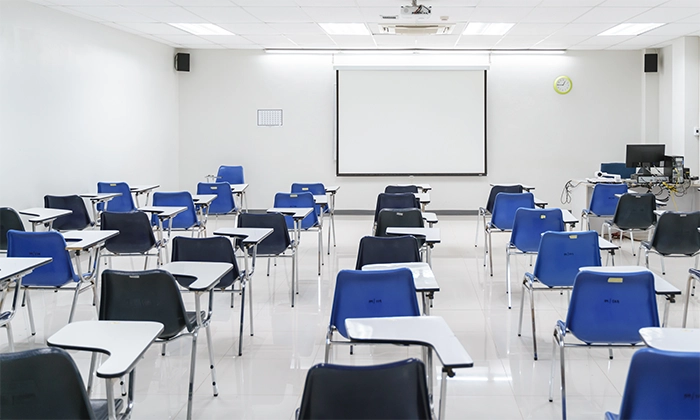Today’s classroom, the new normal

Knowing what to do with class time is a great challenge for educators. The increased presence of technology presents us with two inviting opportunities to relish:
- Engage students with some pre-learning techniques outside of the classroom and keep them accountable for their own learning;
- Open up the classroom group space to hands-on, active and authentic learning experiences that test the application of newly learned skills.
Let’s dive a little into both of these opportunities.
Pre-learning as homework
Pre-learning is a waste of time if they don’t bother watching the videos at home
Blending traditional modes of delivery with a variety of other methods gives educators a new way of approaching class time and homework. If we think of homework traditionally as the primary domain in which to put to use or practice what is learned in class, there are always challenges when students turn up for the next lesson without having completed it. Detractors of the flipped environment immediately point to this as an initial roadblock: ‘if I set my students a video to watch, or some other form of pre-learning, and they don’t do it in the same way that they don’t do normal homework, how can I proceed with the lesson?
My answer to that has always been the same - get used to your students proceeding at a different pace, being at a different stage or needing to work in a completely redefined space. For the educator, this conundrum presents us with the opportunity to think carefully about exactly how to reconfigure our classroom allowing for the various activities needed to give life to a differentiated learning space.
When we employ different modalities, whether it be blended, flipped, video learning or a range of other active learning strategies, both in the classroom and at home, we not only go beyond merely teaching content, but also allow time for teaching the application of skills. Some may breeze through, some may need help; some may experience access difficulties. The worst thing we can do in such a situation is to re-teach yesterday’s lesson - there is no accountability there. The best remedy is to set up the classroom in small pods, differentiated learning hubs for the various stages of the activity cycle. Some may be able to go on with the associated mapping or sequencing exercises, some may need assistance with the content material; some may still need to watch the video. Reconfiguring our classroom to enable students to pace themselves and work with peers at a similar level frees us up to deep dive into small group activities.
Teaching kids to think
This leads me to the exciting active learning strategies we may seek to employ in class. All of our students know how to think, but we can use class time to develop their thinking more creatively, critically, and deeply. The key is making connections.
This can be through a range of activities, including group or project-based work, technology-rich and online activities, peer teaching, and so on. Students who are actively participating in and reflecting on these types of activities will generally enhance their higher order thinking capabilities. Integrating any form of technology into your teaching practice to assist with this can transform learning outcomes.
How? It is generally accepted that through passive learning, students will learn how to ‘repeat and do’. It is the backbone of late 19-20th century rote learning. Not that it is all negative. Direct or explicit instruction takes its impetus from these beginnings and, like most methodologies, it has its benefits. My preference is to balance passive activities with ones at the appropriate stage of learning. Engaging students in inquiry-based problem-solving and collaborative exercises, allows them to control their own learning and transfer their knowledge beyond the classroom.
So much of what we do in the classroom, through no fault of our own, is very much on a superficial level getting not much further than the bottom rungs of Bloom’s taxonomy of communicating knowledge and understanding. What is far more satisfying is to be able to teach students how to think, how to step back and ask questions about what they are learning and to develop their questioning and reasoning.
At the core of the Visible Thinking pedagogy are practices that help make thinking visible with routines that guide the learners’ thought processes and encourage active engagement like analysing; separating or breaking a whole into parts; applying standards; discriminating; reasoning and prediction. Employed strategically, activities emphasising these key skills will lift students beyond mere knowledge accumulation.
Getting our head around a new mindset
There are probably four giant leaps we all have to make in our mindset when we consider what a reconfigured classroom might look like:
- We first have to accept a whole different approach to teaching and learning;
- We will invariably have to invest in some research, reading, and re-training;
- We have to accept that this is all going to take time, so we have to set aside time for it;
- Everyone says it saves you time in the classroom for more engaging activities for your students, which is something else to think about.
Wait there’s more - cognitive AND affective benefits
There is no doubt that a link exists between student wellbeing and student achievement. Indeed one of the fundamental reasons why the traditional classroom paradigm is being challenged by this type of technology-rich pedagogy is the positive impact it has on the teacher-student relationship, ultimately leading to improved achievement.
When active learning strategies are employed, in general, we have a far greater opportunity to tap into deeper learning. As teachers, we are far more likely to have a large and positive impact on our students, both cognitively and affectively if we:
● Are passionate about helping them learn;
● Forge positive relations with them;
● Personalise their learning experience;
● Actively seek to constantly improve and build on our own teaching experience.
In a nutshell
The classroom of the 21st century – the new normal, relies on leveraging all sorts of connections we make to develop a more engaged and sustained interaction for our students. Above all else, it requires us all as educators to be as engaged as we want our students to be. If for nothing else, that in itself it’s a wonderful way to challenge ourselves in order to grow.
I would love to know your thoughts on how your classroom has evolved so shoot through an email here.
References
Subscribe to our newsletter
Get the latest teaching and learning insights delivered to your inbox.
You can unsubscribe at any time, no hard feelings.
Subscribe to our newsletter
Get the latest teaching and learning insights delivered to your inbox.
You can unsubscribe at any time, no hard feelings.
What's Atomi?
Easy to understand, super engaging, and matching what you’re learning in class. Available for 100s of subjects across your high school years.
With heaps of questions and smart AI feedback that shows you what you’ve nailed and what to work on—so you won’t just feel ready, you’ll be ready.
Improve your study game, get AI-driven tips tailored to you, keep tabs on your progress and unlock insights so you can always hit your goals.
What's Atomi?
Captivating and impactful video-first content, fit for all types of learners and grounded in the absolute must-have info of the high school curriculum.
Active recall quizzes, topic tests and exam practice enable students to get immediate feedback and build skills, while allowing teachers to differentiate instruction.
Create engaging learning experiences with easy-to-use tasks, get actionable insights to differentiate instruction and experience intelligent personalisation for your students.
What's Atomi?
Short, curriculum-specific videos and interactive content that’s easy to understand and backed by the latest research.
Active recall quizzes and practice sessions enable students to build their skills, put knowledge into practice and get feedback.
Our AI understands each student's progress and makes intelligent recommendations based on their strengths and weaknesses.




